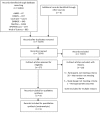Should exercises be painful in the management of chronic musculoskeletal pain? A systematic review and meta-analysis
- PMID: 28596288
- PMCID: PMC5739826
- DOI: 10.1136/bjsports-2016-097383
Should exercises be painful in the management of chronic musculoskeletal pain? A systematic review and meta-analysis
Abstract
Background: Chronic musculoskeletal disorders are a prevalent and costly global health issue. A new form of exercise therapy focused on loading and resistance programmes that temporarily aggravates a patient's pain has been proposed. The object of this review was to compare the effect of exercises where pain is allowed/encouraged compared with non-painful exercises on pain, function or disability in patients with chronic musculoskeletal pain within randomised controlled trials.
Methods: Two authors independently selected studies and appraised risk of bias. Methodological quality was evaluated using the Cochrane risk of bias tool, and the Grading of Recommendations Assessment system was used to evaluate the quality of evidence.
Results: The literature search identified 9081 potentially eligible studies. Nine papers (from seven trials) with 385 participants met the inclusion criteria. There was short- term significant difference in pain, with moderate quality evidence for a small effect size of -0.27 (-0.54 to -0.05) in favour of painful exercises. For pain in the medium and long term, and function and disability in the short, medium and long term, there was no significant difference.
Conclusion: Protocols using painful exercises offer a small but significant benefit over pain-free exercises in the short term, with moderate quality of evidence. In the medium and long term there is no clear superiority of one treatment over another. Pain during therapeutic exercise for chronic musculoskeletal pain need not be a barrier to successful outcomes. Further research is warranted to fully evaluate the effectiveness of loading and resistance programmes into pain for chronic musculoskeletal disorders.
Prospero registration: CRD42016038882.
Keywords: Meta-analysis; Systematic review; effectiveness; exercise; musculoskeletal disorder; musculoskeletal pain; treatment.
© Article author(s) (or their employer(s) unless otherwise stated in the text of the article) 2017. All rights reserved. No commercial use is permitted unless otherwise expressly granted.
Conflict of interest statement
Competing interests: None declared.
Figures






Similar articles
-
Antidepressants for pain management in adults with chronic pain: a network meta-analysis.Health Technol Assess. 2024 Oct;28(62):1-155. doi: 10.3310/MKRT2948. Health Technol Assess. 2024. PMID: 39367772 Free PMC article.
-
Physical activity and exercise for chronic pain in adults: an overview of Cochrane Reviews.Cochrane Database Syst Rev. 2017 Apr 24;4(4):CD011279. doi: 10.1002/14651858.CD011279.pub3. Cochrane Database Syst Rev. 2017. PMID: 28436583 Free PMC article.
-
Back Schools for chronic non-specific low back pain.Cochrane Database Syst Rev. 2017 Aug 3;8(8):CD011674. doi: 10.1002/14651858.CD011674.pub2. Cochrane Database Syst Rev. 2017. PMID: 28770974 Free PMC article.
-
Systemic pharmacological treatments for chronic plaque psoriasis: a network meta-analysis.Cochrane Database Syst Rev. 2021 Apr 19;4(4):CD011535. doi: 10.1002/14651858.CD011535.pub4. Cochrane Database Syst Rev. 2021. Update in: Cochrane Database Syst Rev. 2022 May 23;5:CD011535. doi: 10.1002/14651858.CD011535.pub5. PMID: 33871055 Free PMC article. Updated.
-
Physical activity and exercise for chronic pain in adults: an overview of Cochrane Reviews.Cochrane Database Syst Rev. 2017 Jan 14;1(1):CD011279. doi: 10.1002/14651858.CD011279.pub2. Cochrane Database Syst Rev. 2017. Update in: Cochrane Database Syst Rev. 2017 Apr 24;4:CD011279. doi: 10.1002/14651858.CD011279.pub3. PMID: 28087891 Free PMC article. Updated.
Cited by
-
[The diagnosis and management of medial tibial stress syndrome : An evidence update-German version].Unfallchirurg. 2019 Nov;122(11):848-853. doi: 10.1007/s00113-019-0666-0. Unfallchirurg. 2019. PMID: 31628497 Review. German.
-
Current management strategies for patellofemoral pain: an online survey of 99 practising UK physiotherapists.BMC Musculoskelet Disord. 2017 May 8;18(1):181. doi: 10.1186/s12891-017-1539-8. BMC Musculoskelet Disord. 2017. PMID: 28482879 Free PMC article.
-
Development and feasibility of a conceptual model for planning individualised physical exercise training (IPET) for older adults: a cross-sectional study.BMJ Open. 2024 Mar 5;14(3):e075726. doi: 10.1136/bmjopen-2023-075726. BMJ Open. 2024. PMID: 38448065 Free PMC article.
-
Behavioral Medicine Physiotherapy in the Context of Return to Work for Chronic Pain: A Single-Case Experimental Design Study.Int J Environ Res Public Health. 2022 Jan 28;19(3):1509. doi: 10.3390/ijerph19031509. Int J Environ Res Public Health. 2022. PMID: 35162528 Free PMC article.
-
Use of a Portable Inertial Measurement Unit as an Evaluation Method for Supraspinatus Muscle: Proposed Normative Values.Sensors (Basel). 2021 Nov 20;21(22):7723. doi: 10.3390/s21227723. Sensors (Basel). 2021. PMID: 34833798 Free PMC article.
References
Publication types
MeSH terms
LinkOut - more resources
Full Text Sources
Other Literature Sources
Medical
Miscellaneous
